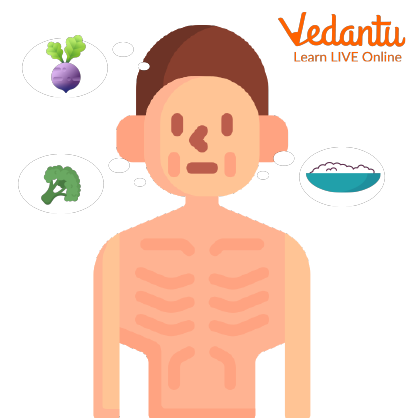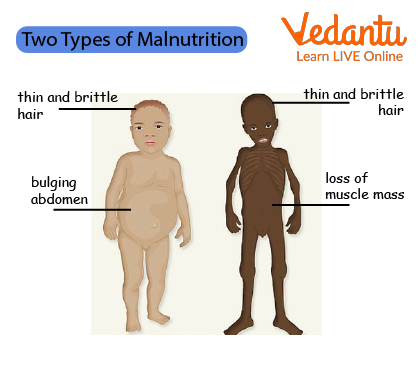




Key Facts About Malnutrition in Children and How to Prevent It
Malnutrition is a condition where an individual doesn't get the perfect proportion of supplements. The human body needs supplements to live and develop. It gets the supplements from food. A few types of unhealthiness happen because the body gets an over-the-top supplement.
Different structures happen because the body doesn't get sufficient supplements. A body can become malnourished due to an ill-advised diet or because a deformity in the body holds it back from handling food the correct way.
Better nutrition can cure malnutrition. Many kids in India are suffering from malnutrition. Malnutrition kids count more in India. Malnutrition symptoms are different for various malnutrition types.

Malnutrition
Cause and Types of Malnutrition
There are different types of malnutrition caused due to deficiencies. Let's discuss each separately.
Lack of Protein
The most widely recognized type of lack of healthy sustenance is protein-energy unhealthiness. This happens when an individual gets too little protein, a couple of calories, or both. Kwashiorkor is an extreme lack of protein. It is normal among small kids in agricultural nations. So, lack of protein is one of the major causes of malnutrition.
They are taken care of bland food varieties, like cereal grains and cassava, and very little protein. Kwashiorkor prompts shortcomings, paleness, inability to develop, and expanding of the gut. Youngsters who experience the ill effects of kwashiorkor eat an adequate number of calories but insufficient protein.
Marasmus is one more sort of hunger that results from insufficient protein or calories. Kids with marasmus don't develop as expected, and their fat and muscles die. Different side effects incorporate parchedness and dry, free skin. Marasmus happens for the most part among extremely small kids, ordinarily under starvation conditions. Childhood malnutrition is a common disease.
Lack of Vitamins or Minerals
People who do not receive vitamins and minerals for a long period can develop certain disorders. The problems rely upon which nutrient or mineral is lacking or missing from the eating routine. For example, an absence of iron causes sickliness, and an absence of iodine causes goitre (expansion of the thyroid organ).
Lack of vitamin A can cause visual deficiency or loss of vision. Youngsters who need more vitamin D can't assimilate calcium effectively. This can prompt rickets. Rickets is a youth illness that makes bones delicate. Delicate bones lead to unusual bone development. Hence, lack of vitamin or minerals also become one of the causes of malnutrition.
Nutritional Disorders
Obesity is a type of malnutrition. It is the point at which a body consumes a larger number of calories than it can utilise. This makes the body have an excessive amount of additional fat. Stoutness can add to numerous medical issues, including hypertension, coronary illness, stroke, diabetes, and joint inflammation.
Malnutrition can likewise be brought about by dietary issues. Anorexia nervosa is one such dietary problem. An anorexic individual eats next to no food as a result of areas of strength for putting on weight. Bulimia nervosa is one more sort of dietary problem. It can likewise create healthful issues.
The below malnutrition images shows what basic difference is there between the two types of malnutrition.

Malnutrition
Summary
The deficiency of nutrients leads to malnutrition. There are many cases of malnutrition all over the world. This is a curable condition. Proper care of patients can resolve this issue. Rickets can create bent legs, thump knees, a protruding temple, and a short level. L-ascorbic acid insufficiency prompts scurvy. Scurvy causes enlarged and draining gums with slackened teeth, irritation of the joints and legs, and frailty. Lack of vitamin B12 can cause blood problems and influence the sensory system.
The absence of vitamin B12 can likewise make the digestive tract capability inappropriate. Too little thiamin in an eating routine can bring about beriberi. Beriberi harms the nerves and heart. Folic corrosive inadequacies can cause sickness and different issues.
FAQs on What Is Malnutrition in Kids? Causes, Signs & Prevention
1. What are the main types of malnutrition found in children?
According to the World Health Organization (WHO), undernutrition in children is broadly classified into four main types:
- Stunting: This refers to a child who is too short for their age, indicating chronic or long-term malnutrition.
- Wasting: This is defined as low weight-for-height. It often signals acute or recent malnutrition and significant weight loss.
- Underweight: This means a child has a low weight for their age. A child can be underweight without being stunted or wasted.
- Micronutrient Deficiencies: This is a lack of essential vitamins and minerals, such as iron, vitamin A, and iodine, which are crucial for growth and development.
2. What are the most common signs and symptoms of malnutrition in kids?
The symptoms of malnutrition can vary but often include a combination of physical and behavioural signs. Key indicators to watch for in a child are:
- Failure to grow in height or weight at the expected rate.
- Constant tiredness, low energy levels, and irritability.
- A weakened immune system, leading to frequent infections.
- Dry, pale skin, and brittle hair that may change colour or fall out easily.
- A swollen abdomen or legs (oedema).
- Delayed physical and cognitive development.
3. What are the primary causes of childhood malnutrition?
The primary cause of malnutrition is an imbalanced diet that lacks the necessary calories, proteins, vitamins, and minerals. However, this is often linked to deeper underlying factors such as:
- Inadequate Food Intake: Not having enough food to eat due to poverty or food insecurity.
- Poor Diet Quality: Consuming foods that are low in essential nutrients.
- Infections and Diseases: Illnesses like diarrhoea or measles can prevent the body from absorbing nutrients properly.
- Lack of Awareness: Insufficient knowledge about a child's nutritional needs and proper feeding practices.
4. How does malnutrition affect a child's physical and mental development?
Malnutrition has profound and lasting effects on a child's development. Physically, it leads to stunted growth, muscle wasting, and a compromised immune system, making the child vulnerable to diseases. Mentally and cognitively, it can impair brain development, leading to learning difficulties, poor concentration, and lower academic performance. These effects can limit a child's potential for the rest of their life.
5. What is the difference between undernutrition and overnutrition in the context of childhood malnutrition?
Both undernutrition and overnutrition are forms of malnutrition. The key difference lies in the type of nutritional imbalance. Undernutrition results from a deficiency of calories, protein, or essential vitamins and minerals, leading to conditions like stunting and wasting. In contrast, overnutrition is caused by an excessive intake of calories, which can lead to a child being overweight or obese, increasing their risk for chronic diseases later in life.
6. Beyond just a healthy diet, what does the treatment for severe childhood malnutrition involve?
Treating severe malnutrition is a comprehensive process that goes beyond simply providing food. It often requires medical supervision and includes:
- Therapeutic Foods: Using specially formulated, nutrient-dense foods like Ready-to-Use Therapeutic Food (RUTF).
- Medical Care: Treating any underlying infections or health conditions that contribute to malnutrition.
- Careful Rehydration: Administering special rehydration solutions to manage dehydration without overloading the child's system.
- Nutritional and Family Support: Educating caregivers on proper feeding practices and providing ongoing support to prevent relapse.
7. How can malnutrition in children be prevented at the family and community level?
Preventing malnutrition requires a multi-pronged approach. At the family level, key strategies include exclusive breastfeeding for the first six months, providing a diverse and balanced diet, and ensuring regular health check-ups. At the community level, prevention involves educating caregivers about nutrition, improving access to clean water and sanitation to reduce infections, and implementing programmes that ensure food security for vulnerable families.
8. Why are children, especially those under five, more vulnerable to malnutrition than adults?
Children under five are particularly vulnerable to malnutrition for several reasons. Their bodies are in a state of rapid growth and development, which means they have higher nutritional requirements relative to their body size. Their immune systems are not yet fully developed, making them more susceptible to infections that can deplete nutrients and worsen their nutritional status. Furthermore, they are completely dependent on caregivers for their food and health, making them susceptible to issues like poverty and lack of parental education.









